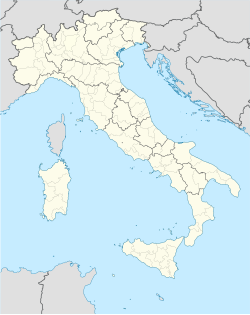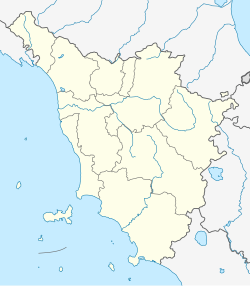Castiglione della Pescaia (Italian pronunciation: [kastiʎˈʎoːne della peˈskaːja]), regionally simply abbreviated as Castiglione, is an ancient seaside town in the province of Grosseto, in Tuscany, central Italy. The modern city grew around a medieval 12th century fortress (Italian: castello) and a large fishery, from which it acquired its designation. Today Castiglione is a very popular tourist destination with attractions that include beaches, natural parks, biking trails, historical Etruscan archaeological sites, a panoramic mediaeval hamlet as well as the natural reserve Diaccia Botrona, a swampy humid environment of historical relevance whose endangered wildlife comprise pink flamingoes, mallards and ducks.
Castiglione della Pescaia | |
|---|---|
| Comune di Castiglione della Pescaia | |
 | |
| Coordinates: 42°45′N 10°52′E / 42.750°N 10.867°E | |
| Country | Italy |
| Region | Tuscany |
| Province | Grosseto (GR) |
| Frazioni | Ampio, Buriano, Macchiascandona, Pian d'Alma, Pian di Rocca, Ponti di Badia, Punta Ala, Riva del Sole, Roccamare, Rocchette, Tirli, Vetulonia |
| Government | |
| • Mayor | Elena Nappi (centre-left) |
| Area | |
• Total | 209.28 km2 (80.80 sq mi) |
| Elevation | 4 m (13 ft) |
| Population (31 December 2017)[2] | |
• Total | 7,289 |
| • Density | 35/km2 (90/sq mi) |
| Demonym | Castiglionesi |
| Time zone | UTC+1 (CET) |
| • Summer (DST) | UTC+2 (CEST) |
| Postal code | 58043 |
| Dialing code | 0564 |
| Patron saint | St. William of Aquitania |
| Saint day | 2 May |
| Website | Official website |
Castiglione della Pescaia is home to the second most expensive street in Italy for property prices,[3][4] with average values exceeding those of homes in every other Italian street except one, also in Tuscany.
Geography
editCastiglione della Pescaia consists of a High City built on the hill that ends a chain of hills towards the sea, and of a Low City at the foot of the former, straddling the drainage canal and marina that form the central part of town.
Castiglione is located in the South-Western portion of Tuscany, with a view of the islands of Elba and Giglio, and of the promontory of Argentario. The hills that back the city slope into beaches that front the town in its entirety. To the East of Castiglione is the rich floodplain of the Ombrone river. Nothing much remains of the ancient lake Prile that used to be Castiglione's lifeblood.
Despite Castiglione's popularity as a holiday destination, the town's natural surroundings - including the sea, marshes and pinewoods typical of the Maremma area - have been meticulously preserved and are today forming protected natural reserves. Notably, in 2015 Castiglione's sea was nominated as Italy's most beautiful by the national non-governmental environmentalist organisation Legambiente, which not only praised the town's seawater cleanliness but also its environmental efforts and efficient recycling.[5]
Castiglione is the most visited seaside destination in Tuscany and it ranks second among the most visited cities in the region,[6] being only preceded by Florence. In 2019, approximately 1.6 million tourists visited Castiglione reaching an historic record.[7] The town is also one of the most visited in Italy.[8]
History
editWhile Umbrians and Etruscans were most likely the first inhabitants of its location, Castiglione della Pescaia was first recorded under the name Salebrone in Roman times. The hill close to the coast proved to be an excellent location, as it dominated the sizable inland Prelius Lake, while the lake itself provided fish for food and salt, which could be traded.
In the Middle Ages, the city suffered repeated pirate attacks and almost disappeared. It resurfaced in the 9th century AD under its current name, under joint protection of the Papacy and the Republic of Pisa.
The Pisans used Castiglione as a key element in their system of defence along the Tyrrhenian coast. They built first a single tower on top of the hill, later expanded that to three towers joined by a wall that became the nucleus of the citadel. The three towers of Castiglione dominate the city seal to this day.
In the 13th century, Castiglione became an independent comune. Meanwhile, the river Ombrone had started silting up Lake Prile, which soon became a lagoon. In this newly formed lagoon, malaria mosquitoes took hold, weakening the population of Castiglione. The city requested protection from various powers (Siena, the Medici, Aragon) and finally became part of the Grand Duchy of Tuscany under the House of Habsburg-Lorraine.
The House of Lorraine started a series of projects that greatly enhanced the lives of Castiglionesi. The swamps were drained over decades, increasing the amount of arable land, as well as killing off the malaria-carrying mosquitoes.
After Tuscany became part of Italy in 1859, Castiglione became a comune in the province of Grosseto.
Government
editFrazioni
editThe municipality is formed by the municipal seat of Castiglione della Pescaia and the villages (frazioni) and hamlets of Buriano, Pian d'Alma, Pian di Rocca, Punta Ala, Roccamare, Rocchette, Tirli and Vetulonia.
List of mayors
edit| Mayor | Term start | Term end | Party |
|---|---|---|---|
| Carlo Mini | 1946 | 1953 | |
| Otello Carraresi | 1953 | 1961 | |
| Walter Vannucci | 1961 | 1964 | |
| Fedro Mirolli | 1964 | 1977 | |
| Giancarlo Farnetani | 1978 | 1990 | Italian Communist Party |
| Dario Viti | 1990 | 1992 | Italian Communist Party/Democratic Party of the Left |
| Massimo Emiliani | 1993 | 1996 | Italian Radicals |
| Franco Roggiolani | 1996 | 2001 | Democratic Party of the Left/Democrats of the Left |
| Monica Faenzi | 2001 | 2011 | Forza Italia/The People of Freedom |
| Giancarlo Farnetani | 2011 | 2021 | Democratic Party |
| Elena Nappi | 2021 | incumbent | centre-left civic list "Castiglione Futura" |
Main sights
editOne of the most popular tourist destinations in the area is the historical Etruscan centre of Vetulonia, which hosts an Etruscan museum with an adjacent well preserved archaeological site, encompassing ancient remains of the old inhabitants of Maremma. Furthermore, the hamlets of Punta Ala, Riva del Sole, Roccamare and Rocchette are beach resorts catering mostly tourists from Central and Northern Europe.
In the territory of Castiglione della Pescaia, the 1,000-hectare (2,500-acre) Natural Reserve of Diaccia Botrona (with 18th-century Casa Rossa Ximenes) is a designated wetland area of international interest, according to the Ramsar Convention.
References
edit- ^ "Superficie di Comuni Province e Regioni italiane al 9 ottobre 2011". Italian National Institute of Statistics. Retrieved 16 March 2019.
- ^ "Popolazione Residente al 1° Gennaio 2018". Italian National Institute of Statistics. Retrieved 16 March 2019.
- ^ "La via con le case più care d'Italia? È nella patria del Brunello". gonews.it (in Italian). 2019-09-12. Retrieved 2020-12-14.
- ^ Nazione, La (12 September 2019). "Case da sogno in Toscana, sono qui le dimore più lussuose d'Italia". La Nazione (in Italian). Retrieved 17 December 2020.
- ^ "In Toscana il mare più bello d'Italia: è a Castiglione della Pescaia - la Repubblica".
- ^ "La Maremma regina del turismo in Toscana: Castiglione e Grosseto al top nella classifica delle presenze - IlGiunco.net".
- ^ "Turismo: 1,6 milioni di presenze a Castiglione nel 2019. E' record - IlGiunco.net".
- ^ "I PRIMI 50 COMUNI ITALIANI PER NUMERO DI PRESENZE TURISTICHE". Time2marketing (in Italian). 2018-12-12. Retrieved 2020-12-15.


